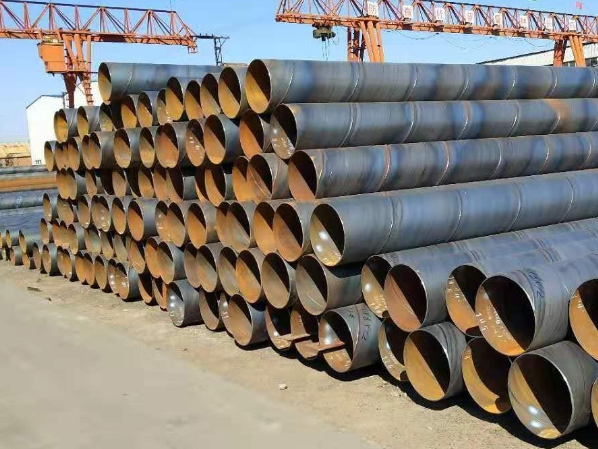Seamless pipes (SMLS) and spiral pipes (SSAW) are two common types of steel pipes, which have certain differences in manufacturing process, performance and application fields.
1. Manufacturing process
Seamless pipe: As the name suggests, seamless pipe is a steel pipe without welds. It is to make the wall thickness and diameter of the steel pipe meet the required specifications by piercing the circular solid steel billet, and then rolling, stretching and other processes. The production process of seamless steel pipe does not involve welding, so it has higher uniformity and integrity.
Spiral pipe: Spiral pipe is made by rolling a strip steel plate into a tube shape and performing spiral welding at the seam. The production process of the spiral steel pipe is relatively simple, the production efficiency is high, and the steel pipe with a larger diameter can be produced. However, due to the existence of welds, the strength and uniformity of spiral pipes are relatively low.

2. Performance
Due to its uniform material and weldless structure, seamless pipe has high strength, tensile and compressive properties. Therefore, it is usually used in occasions subject to higher pressure and temperature, such as pipeline systems in oil, gas and chemical industries.
Due to the presence of welds, the spiral steel pipe has relatively low strength and compression resistance, but it can still meet the needs of most low-pressure transmission systems, such as water, sewage and natural gas. In addition, the production cost of spiral steel pipe is relatively low, so it is more competitive in price.
3. Application fields
Seamless pipes are widely used in high-pressure and high-temperature occasions such as petroleum, natural gas, chemical industry, electric power, and boilers. Due to its excellent properties, seamless steel pipes can also be used to manufacture precision equipment and high-performance parts.
Spiral pipes are mainly used in low-pressure transmission systems, such as municipal water supply, drainage, oil, natural gas, etc. In addition, spiral steel pipe can also be used in engineering fields such as structural support and bridge construction.
In short, seamless pipes and spiral pipes have their own advantages and disadvantages, and the selection needs to be evaluated according to actual needs and application scenarios. In the case of high pressure and temperature, seamless steel pipe is a better choice; in low-pressure conveying systems with greater demand in terms of cost and caliber, spiral steel pipe is a more economical and practical choice.
4. Weld seam
Seamless pipe has no welds, and the material and structure of the entire pipe are very uniform. This makes the seamless pipe better able to withstand stress when subjected to external pressure, reducing the risk of leakage.
The welds of the spiral pipe are distributed along the spiral direction, which means that when subjected to external pressure, the stress on the welds is relatively high. Therefore, strict quality control of weld seams is required when using spiral steel pipes in high-pressure environments.
5. Size range
The
size range of seamless pipes is relatively small, usually within a certain range of diameter and wall thickness. For steel pipes with special specifications and large diameters, the production of seamless steel pipes is more difficult and costly.
Spiral steel pipes have a wide range of sizes and can produce steel pipes with larger diameters and different wall thicknesses. Due to its relatively simple production process, spiral steel pipe is a more suitable choice for special specifications and large diameter requirements.
To sum up, seamless pipes and spiral steel pipes are different in terms of manufacturing process, performance, application fields, weld seam and size range. When choosing, it is necessary to comprehensively consider factors such as actual needs, application environment, and budget to ensure that the most suitable type of steel pipe is selected.
Seamless Pipe vs Welded Pipe
In terms of performance, seamless pipes have greatly improved the pressure bearing capacity compared with welded steel pipes, so they are often used in high-pressure equipment. Such as the pipeline connection of hydraulic equipment, etc. The weld seam part of the welded pipe is its weak link, and the quality of the weld seam is also the main factor affecting its overall performance.
Go here to learn more about "Carbon steel vs Stainless steel"


